Apple's iPhone 4: Thoroughly Reviewed
by Brian Klug & Anand Lal Shimpi on June 30, 2010 4:06 AM EST- Posted in
- Smartphones
- Apple
- iPhone 4
- Gadgets
- Mobile
Performance
When the 4 was announced, my curiosity (and perhaps yours as well?) was about the flavor of Apple’s A4 SoC inside the phone. The rumor was that the A4 in the iPhone 4 had a full 512MB of memory, compared to 256MB in the iPad’s A4. iFixit took an iPhone 4 apart (with relative ease I might add) and confirmed the presence of 512MB. Look at the A4 in this picture, the Samsung part number on the right edge of the chip starts out K4X4G. The K4X denotes a Samsung mobile DRAM and the 4G refers to its density: 4Gbit or 512MB.
More memory should mean a smoother multitasking experience on the iPhone 4. Remember that iOS 4 keeps all fast task switching enabled apps resident in memory even after you’ve switched away from them. They are only kicked out of memory if you run low or if you force quit them. With more memory you should be able to keep more apps in memory without unwillingly forcing them out. The 512MB of RAM should also give the OS more breathing room in lighter multitasking scenarios, a problem many are already seeing on the iPhone 3GS running iOS 4. In practice the 4 is smoother when running iOS 4. There are still some hiccups but not as bad as on the 3GS, and definitely not as bad as on the 3G. The OS was clearly designed with the iPhone 4 as the performance target.
The big question that remains is what clock speed the iPhone 4’s A4 is running at. The assumption was 1GHz however Apple was very careful not to mention clock speed, unlike at the iPad launch. Saying nothing usually means there’s nothing good to say.
I ran a whole bunch of benchmarks on the iPhone 4 and the iPhone 3GS running iOS 4 to try and figure out what CPU speed we might be dealing with. The early reviews imply that the A4 in the iPhone 4 is running at a speed greater than the 3GS’s 600MHz, but slower than the iPad’s 1GHz. Let’s try and find out what it’s really running at.
We’ll start with the real world tests, first SunSpider. A javascript performance test this benchmark is completely network independent but it measures the performance of the browser as well as the underlying hardware. It is small enough to make memory size differences negligible so between the two iPhones we should be seeing a pure CPU comparison:
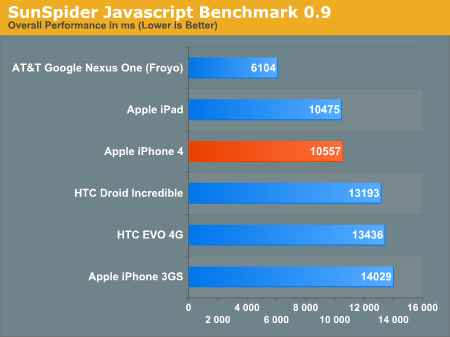
The iPhone 4 manages a time that’s 25% faster. Note that this test is just as much about the software stack as it is about CPU/platform performance. The Froyo update makes the Nexus One ridiculously fast in this benchmark. It just shows you how much room there is to improve performance on these Android handsets. The next leapfrog is going to be once the entire Android world moves to 2.2.
Next up is the Rightware BrowserMark. This test combines JavaScript and HTML rendering performance:
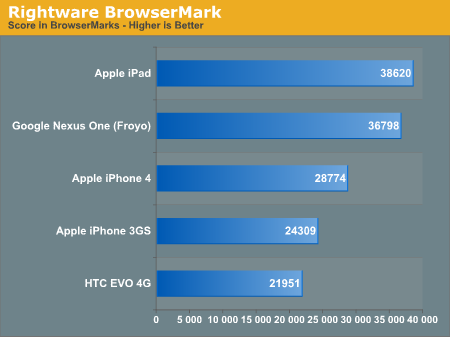
BrowserMark spits out an overall score but with no indication of what the score actually means. In this case we’re looking at 18.4% better performance than the iPhone 3GS. The iPad is 34% faster than the 4, which supports the theory of the A4 running at ~750MHz in the new iPhone.
There's also the possibility that the A4 CPU clock varies depending on load and other factors but the run to run consistency in all of our tests seems to indicate otherwise. We also can't ignore the fact that the iPad and iPhone now run vastly different OS revisions. In some cases iOS 4 actually takes a step back in performance compared to iOS 3.2. That undoubtedly makes the iPad vs. iPhone 4 comparison about much more than CPU performance.
Froyo's improved Javascript performance sends the Nexus One nearly to the top of the list here, only bested by the iPad. While Apple has definitely improved performance with the iPhone 4, it seems that it will only take a software update for Android phones to surpass it.
To measure web browsing performance I downloaded a bunch of different web pages and saved as much of them as possible locally on a server. I used WiFi on all of the devices to connect to my local server and timed average load time. I repeated the test at least 3 times and threw out any unusually high or low numbers. Performance was from a clean restart with no additional programs running in memory.
Note that these numbers aren't comparable to other reviews as we've updated software versions on two of the phones. The iPhone 3GS is now running iOS 4 which resulted in some numbers going up while others went down. And the Google Nexus One is running the officially released build of Android 2.2, codenamed Froyo.
What these tests should show is the overall performance of the platform when all network bottlenecks are removed. Obviously hiding in a tunnel under a lead umbrella will make any phone slow, but we’re looking at peak performance here.
The first test is the new AnandTech front page. Here we’ve got tons of images and HTML, meaning we’re stressing both bandwidth and code parsing speed.
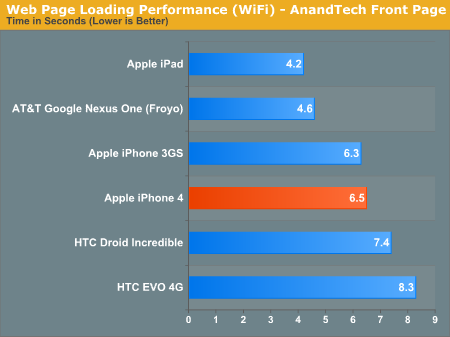
The iPhone 4 is no faster than the 3GS (actually slightly slower, but we'll chalk that up to timing variance) here. The Froyo update to the Nexus One makes it lightning quick, almost as fast as the iPad in our first test.
Next up we have the first page of our recent Zotac XBOX HD-ID11 review. The balance shifts from tons of images to more HTML processing:
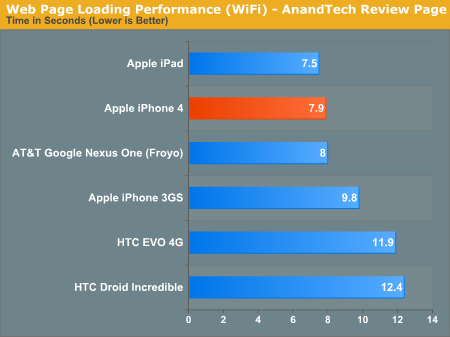
Here we see more of what I expected: the iPhone 4 is around 25% faster than the 3GS running iOS 4. Android 2.2 running on the Nexus One is basically as fast as the 4.
Using our Print this Review function, this next test loads our entire 2010 15-inch Macbook Pro review. While the other two tests had some flash ad content, this one is completely devoid of it so the HTC phones shouldn’t be penalized:
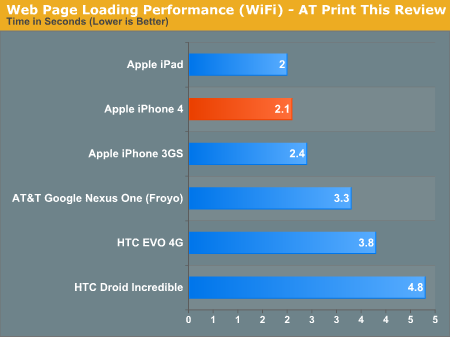
Here the iPhone 4 is 11% faster than the 3GS and about the speed of the iPad. There are other bottlenecks at play here so we don't get further performance scaling. The Froyo update helps the Nexus One a bit but the iOS devices are still quicker.
Our most intensive test is up next with a load of the Engadget front page:

The Nexus One is ahead of the 4 once more with its Froyo update. And the iPhone 4 is 34% faster than the 3GS.
Our most CPU bound test is up next. I put together a custom page with a ton of tabular content and a single page copy of our 15-inch MBP review to make the load take some time at least.
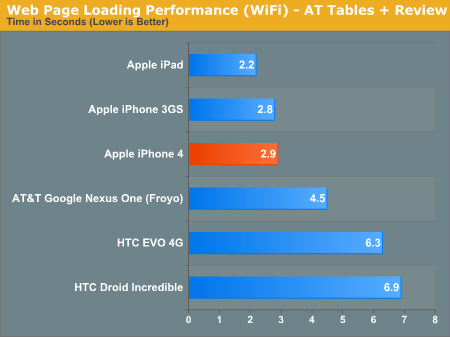
Surprisingly enough there's no difference between the 3GS and the 4 here, perhaps my test is less CPU bound than I thought. Froyo improves the Nexus One's performance a little bit.
Low Level Synthetic Tests
If we assume that we’re mostly CPU bound in all of these cases (a fair assumption given how fast Atom can run through all of these tests), then we’d be looking at a ~750MHz clock speed for the iPhone 4’s A4 assuming no other architectural changes. That’s actually a pretty big assumption. The A4 is widely believed to be a 45nm SoC using an ARM Cortex A8. At 45nm there should be room for a larger L2 cache than what was used in the iPhone 3GS’s SoC.
Perhaps some more synthetic tests will help us figure out what’s going on. I turned to Geekbench, now available in an iOS version.
Geekbench spit out a number of overall results that gave me a good enough summary of what’s going on to make an educated guess:
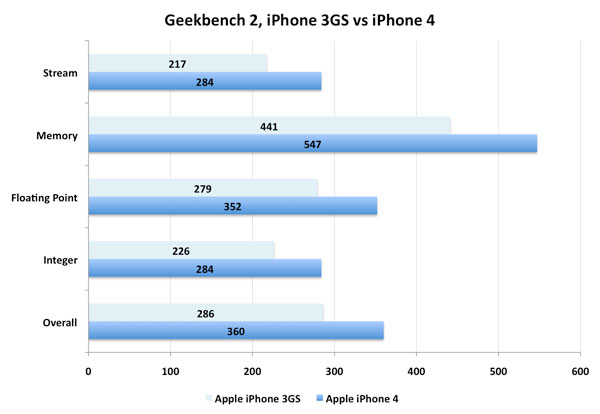
The CPU specific tests all indicate the iPhone 4 is around 25% faster than the iPhone 3GS. That would imply at least a 750MHz clock speed if all else is the same. Assuming we don’t get perfect CPU scaling with all of these tests, I’d venture a guess that 800MHz is more accurate. If the A4 does indeed have larger caches however, Apple could get away with a lower clock speed.
The memory results are particularly telling as they all scale very well going to the iPhone 4, better than the CPU results in fact. This could lend credibility to the theory of larger internal caches or perhaps to an improved (faster) memory subsystem.
Unfortunately until we get the iPad on iOS 4 we can't get a better idea of CPU scaling. I'm not even sure how reliable that will be at this point. If Apple was willing to change the amount of memory the A4 package housed between the iPad and iPhone 4, who is to say that it wouldn't have a slightly different design for the iPhone 4 (e.g. larger caches). The designs may not be physically different but we may instead be looking at binning. Given Apple's unwillingness to talk about the architecture here I think the safest bet is that we're looking at an 800MHz ARM Cortex A8 core in the iPhone 4 and a 1GHz core in the iPad.
Why the lower clock? It's all about battery life.










270 Comments
View All Comments
Lemurion - Friday, July 2, 2010 - link
I was disappointed that you they only compared the iPhone 4 screen to the 800 by 480 AMOLED screens on some of the Android devices. As far as I know, all those devices use the Pentile system, which reduces the crispness of text.I would have really liked to compare the new Apple screen to the Motorola Droid's 266 PPI screen and see how noticeable the difference there was.
Matt Campbell - Friday, July 2, 2010 - link
Nice investigation work on the signal strength. Just wanted to point out that AnandTech is cited in the Apple iPhone 4 software fix story on CNN today. http://www.cnn.com/2010/TECH/mobile/07/02/apple.ip...Bad Bimr - Friday, July 2, 2010 - link
http://www.cnn DOT com/2010/TECH/mobile/07/02/apple.iphone.apology/index.htmlJust like apple, finally admitting a problem, pleasing the fan boys by saying it will be addressed and doing nothing to fix it. I am so glad I never jumped on the apple bandwagon.
fischerm83 - Friday, July 2, 2010 - link
So i was reading various news articles today and saw that apple finally figured out/admitted to what you guys found out earlier this week...*quote*
Now the company says its engineers have made a "stunning" discovery. Reception is poor and calls may be dropped because not only are people holding the phone wrong, but they also think they have a better signal than they do. In the statement, Apple says that it has made a mistake in the formula that calculates the number of bars that display the signal strength on all of its iPhones.
"We were stunned to find that the formula we use to calculate how many bars of signal strength to display is totally wrong," it said in a statement.
*quote*
Full Article:
http://news.cnet.com/8301-30686_3-20009564-266.htm...
Nice work guys, keep up the amazing work!
anandreader - Friday, July 2, 2010 - link
Brian-I'm confused as to what had to happen to get Fieldtest onto the iphone 4. Understood the bit about jailbreaking the iphone3 but didn't understand how that information got transfered to the 4.
Could you elaborate a bit there?
Per Grenerfors - Friday, July 2, 2010 - link
Thanks for the great review, AnandTech.In countries where 3G coverages isn't spotty like a teenagers face, the whole antenna/at&t/verizon debate is just utterly unnecessary.
Apple is the only brand name in tech today that's recognized by the broader public. Their products therefore make a big splash in the media when they hit the market. But the bigger splash you make, the more mud comes floating up from the bottom. Like people complaining with a spec sheet in hand without ever having seen the device in real life. Or just plain old haters. This is the downside to fame. But I'm sure Apple's laughing all the way to the bank.
Stokestack - Friday, July 2, 2010 - link
A case isn't an acceptable workaround for this. I don't buy a thin phone to bulk it up and junk it up with a cheesy case or add-on of any kind.While I'm not planning on getting an iPhone 4, if I had one and wanted to keep it I'd try to spray a coating onto the antenna band. I'd mask the front & back, the buttons, and any seams, then spray with polyurethane or something. While it would be microscopically thin, there's be no direct contact with skin. And really, that's what you said you expected Apple to have done anyway. Let's see if it would work.
Excellent review. The hack to get the numeric signal strength rocks.
Fulle - Friday, July 2, 2010 - link
Thank you for the review. It was useful to be able to look at something that was detailed, and included facts, good and bad, without a ridiculous amount of bias. It's obvious that Anand likes, or at least really wants to like most Apple products, but it was nice that that didn't get in the way of the review.The new iPhone seems to be an OK device that's on par with new Android smartphones in way of hardware... The screen's got 20% higher pixel density than the Droid, but 50% worse contrast ratio, and worse black quality... Java performance is clearly inferior to a Nexus One, but browsing performance is competitive (I'd say good, but I think all handsets have shit browser performance). Its sleak and thin, but it has no hardware qwerty. The 5MP camera produces low noise, but, the white balance is messed up, making it overall inferior to the camera in a Nexus One or HTC Incredible (or Moto Droid, even, IMHO... screwed up over-saturated colors with bad white balance are a big deal to me). Overall, it's an average device when put up against worthy competition (EVO4G, DroidX, HTC Incredible, Nexus One, or even a Moto Droid).
But, that's before you have to deal with the obvious design flaws. Glass panels on both sides? WTF? Uninsulated external antenna? These aren't minor flaws here.
So, overall I'd say that the new iPhone is inferior to at least 6 Android smartphones.... and at first I grin at that... but then I'm disappointed and mad. Apple has helped make the smartphone market the competitive environment it is today, and when they drop the ball like this, it means that other venders don't have to raise the quality of their devices to compete. It's just fortunate that Android has so many hardware OEMs, like HTC, Samsung, and Motorolla, all competing with each other... or else I'd be afraid the only thing the iPhone4 would push in competition is a higher ppi on the screens.
Lets hope this helps push the Cortex-A9 equipped Android's this winter to include higher resolution in their displays... but, man, I'm disappointed with this device.
tgibbs - Friday, July 2, 2010 - link
Does zero dB represent a standard absolute signal strength or is it an arbitrary reference value that will differ for different phones?navderek - Saturday, July 3, 2010 - link
The signal is actually measured in dBm which means it is a reference to 1mW of power.For example -30dBm = 1000 times less that 1mW = 1uW
1 microwatt does not seem like much, but actually this is a very strong signal for the mobile and you would rarely have that much power arriving at your handset from the tower. In good conditions, close to the tower or serving antenna with minimal obstructions you could expect about -50 to -60 dBm (-60dBm = 1nW (nanowatt). The system is designed to deal with such small signals...this is why I laugh when people are worried about cell tower "radiation" when actually 5 min. in the sun is a bazzillion times more radiation than what's coming out of a tower....cellular towers that is, broadcast radio towers or paging systems are another story!
But I digress...to answer your question simply, zero dBm simple equals 1mW.
Zero dBm signifies that there is no difference in ratio from the reference of 1mW.